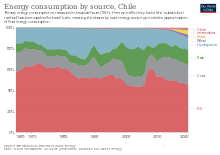Energy in Chile
This article needs additional citations for verification. (July 2009) |

Chile's
Electricity consumption was 68.90 TWh in 2014. Main sources of electricity in Chile are
Electricity
The electricity sector in
Chile’s successful electricity sector reform, which served as a model for other countries, was carried out in the first half of the 1980s. Vertical and horizontal unbundling of
The main companies involved, in terms of installed capacity, are the following:[2]
- Enel Generación Chile (formerly ENDESA; 35%, 6085 MW)
- AES Andes (18%, 3157 MW)
- Colbún S.A. (15%, 2621 MW)
- Suez Energy Andino (12%, 2176 MW)
- E.E. Guacolda (3%, 610 MW)
- Pacific Hydro(3%, 551 MW)
A number of other companies account for the remaining 14% (2418 MW)[2]
Projects
Since the introduction of the so-called "short law II", investments in generation have risen greatly. Currently, there are generation projects amounting to over 26,000 MW, in different stages of development.
Renewable energy and energy efficiency
The two countries will also collaborate on other high-priority energy issues, including energy efficiency technologies and the establishment of two pilot solar power projects in northern Chile.
References
- ^ a b "IEA - Report". www.iea.org. Archived from the original on 2 February 2017. Retrieved 27 January 2017.
- ^ a b c d e Installed Capacity in Chile Central Energía: Up-to-date information of the power capacity installed in Chile. Retrieved 15-05-2012
- ^ Proyectos Eléctricos de Chile[permanent dead link]. Up to date list of electric generation projects. Central Energía. Retrieved: 19-04-2010
- ^ "Total Plans Biggest Unsubsidized Solar Farm for Chile Desert". Bloomberg.com. 26 September 2013.
